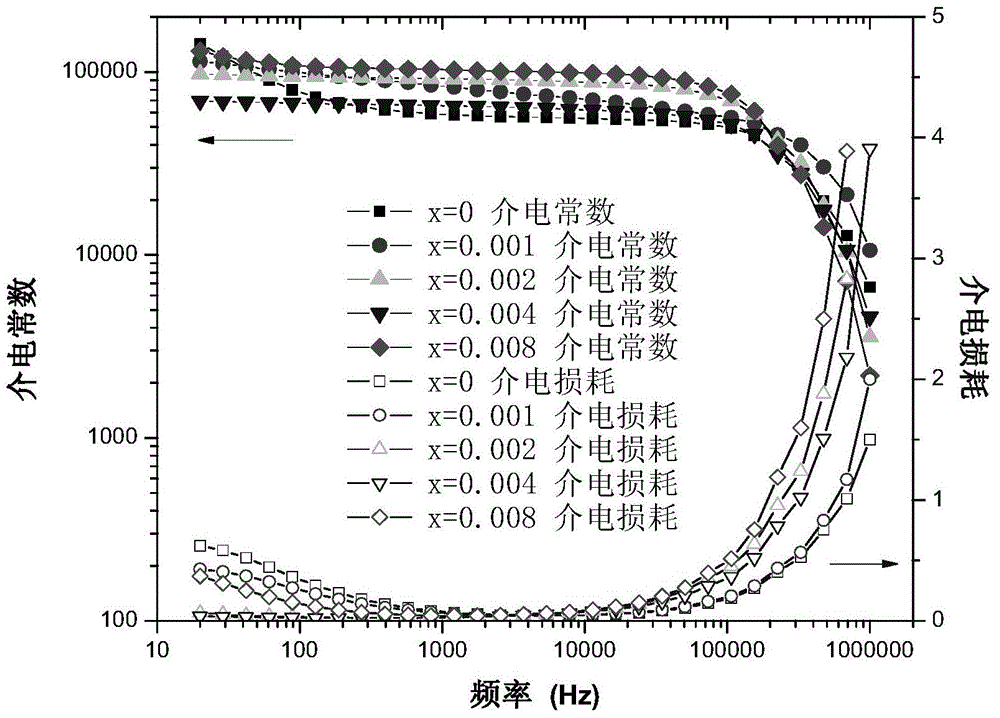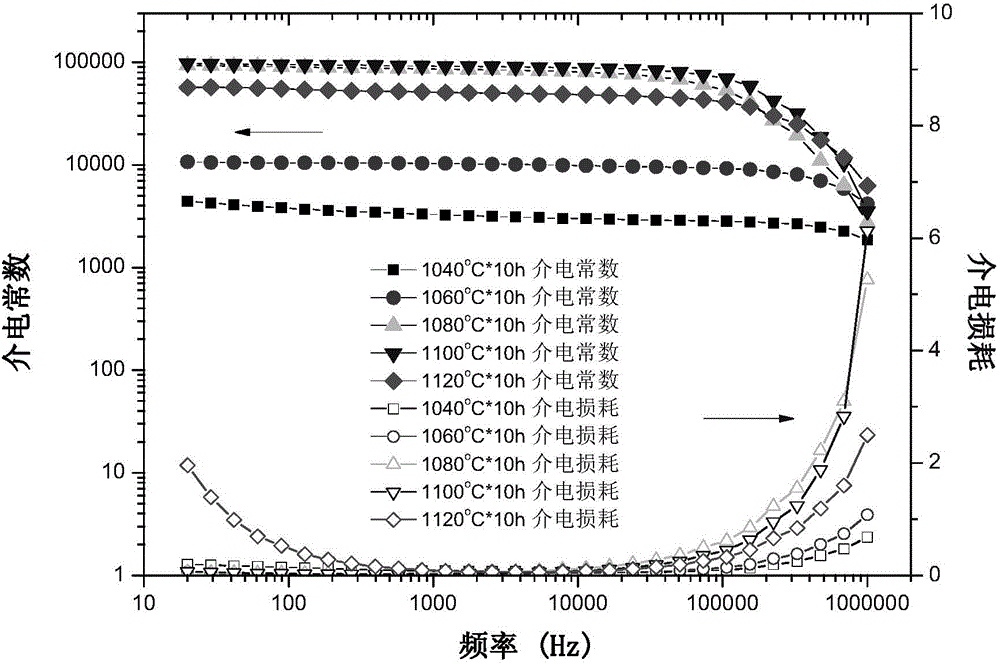Method for manufacturing ceramic material with low dielectric loss, large capacitivity and varistor characteristics
A technology of ceramic material and manufacturing method, which is applied to the manufacturing field of oxide ceramics, can solve problems such as reducing the permittivity, and achieve the effects of reducing dielectric loss, high repeatability, and simple preparation process
- Summary
- Abstract
- Description
- Claims
- Application Information
AI Technical Summary
Problems solved by technology
Method used
Image
Examples
Embodiment 1
[0025] Copper perovskite ceramics (CaCu 3+x Ti 4 o 12 ), wherein the trace amount of copper element exceeds the ceramic material whose stoichiometric ratio x=0.002. First, the main raw material with a purity of 99.0% is weighed according to the stoichiometric ratio of copper oxide: calcium carbonate: titanium dioxide = (3+0.002): 1: 4, and the mass ratio of the total mass of the main raw material mixed is 0.005% of the carbon dioxide Manganese is used as a trace additive, put into a nylon ball mill tank, use distilled water as the ball mill medium, use a planetary ball mill to mill at 300r / min for 4h, and then put the dried powder in a muffle furnace with a heating rate of 3°C / min Raise from room temperature to 930°C for pre-burning and keep warm for 2 hours; after pre-burning, ball mill, pass through 80-mesh sieve, and dry to obtain pre-fired powder; the defoamer used is ELEMENTIS SPECIALTIES ) of Defom W-086, according to the ratio of calcined powder: 5% polyvinyl alcohol...
Embodiment 2
[0027] Copper perovskite oxide ceramics were prepared by solid phase method. First, the main raw material with a purity of 99.0% is weighed according to the stoichiometric ratio of copper oxide: calcium carbonate: titanium dioxide = (3+0.002): 1: 4, and the mass ratio of the total mass of the main raw material mixed is 0.005% zinc oxide As a trace additive, put it into a nylon ball mill jar, use distilled water as the ball milling medium, and use a planetary ball mill to mill at 300r / min for 4h, then put the dried powder in a muffle furnace, and heat up at a rate of 3°C / min from The room temperature was raised to 930°C for pre-burning and kept for 2 hours; after pre-burning, ball milling was carried out, passed through an 80-mesh sieve, and dried to obtain pre-fired powder; the defoamer used was ELEMENTIS SPECIALTIES Defom W-086, according to the ratio of calcined powder: 5% polyvinyl alcohol solution: glycerol: antifoaming agent = 45:40:10:5, was added into the ball mill jar ...
Embodiment 3
[0029] Copper perovskite ceramics (CaCu3+x Ti 4 o 12 ), wherein the trace copper element exceeds the ceramic material whose stoichiometric ratio x=0.004. First, the main raw material with a purity of 99.0% is weighed according to the stoichiometric ratio of copper oxide: calcium carbonate: titanium dioxide=(3+0.004): 1:4, and the mass ratio of the total mass of the main raw material mixed is 0.005% of the carbon dioxide Manganese is used as a trace additive, put into a nylon ball mill tank, use distilled water as the ball mill medium, use a planetary ball mill to mill at 300r / min for 4h, and then put the dried powder in a muffle furnace with a heating rate of 3°C / min Raise from room temperature to 930°C for pre-burning and keep warm for 2 hours; after pre-burning, ball mill, pass through 80-mesh sieve, and dry to obtain pre-fired powder; the defoamer used is ELEMENTIS SPECIALTIES ) of Defom W-086, according to the ratio of calcined powder: 5% polyvinyl alcohol solution: glyc...
PUM
| Property | Measurement | Unit |
|---|---|---|
| dielectric loss | aaaaa | aaaaa |
| dielectric loss | aaaaa | aaaaa |
| dielectric loss | aaaaa | aaaaa |
Abstract
Description
Claims
Application Information
 Login to View More
Login to View More - R&D
- Intellectual Property
- Life Sciences
- Materials
- Tech Scout
- Unparalleled Data Quality
- Higher Quality Content
- 60% Fewer Hallucinations
Browse by: Latest US Patents, China's latest patents, Technical Efficacy Thesaurus, Application Domain, Technology Topic, Popular Technical Reports.
© 2025 PatSnap. All rights reserved.Legal|Privacy policy|Modern Slavery Act Transparency Statement|Sitemap|About US| Contact US: help@patsnap.com


